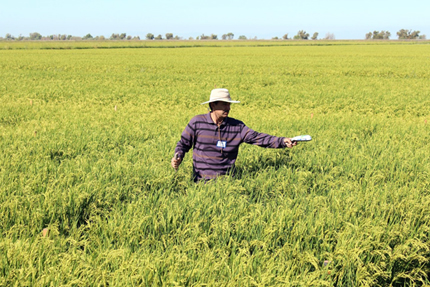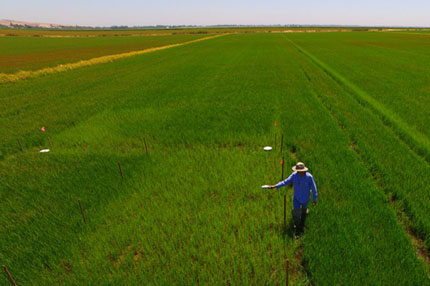5585 Guilford Road • Madison, WI 53711-5801 • 608-273-8080 • Fax 608-273-2021
www.agronomy.org
Twitter | Facebook
NEWS RELEASE
Contact: Hanna Jeske, Associate Director of Marketing and Brand Strategy, 608-268-3972, hjeske@sciencesocieties.org
Technology keeps rice fertilizer nice
Feb. 7, 2018 - Farmers make a lot of decisions. One of the most important is how much fertilizer to apply to their crops, and when to apply it. Applying more than necessary or at the wrong time can waste resources, impact the environment, and cut into narrow profits.
 The answer could lie in a small handheld device. A new tool may help growers make better decisions in applying nitrogen fertilizer to their rice fields.
The answer could lie in a small handheld device. A new tool may help growers make better decisions in applying nitrogen fertilizer to their rice fields.
The most wasteful application of nitrogen fertilizer occurs in the middle of the season, says Telha Rehman. Rehman is a researcher at the University of California, Davis. This is because it’s hard for farmers to know how much nitrogen—an essential nutrient for plants—is already available to the crops. He’s working to find a device that farmers can use to measure the amount of nitrogen already in their crops.
While the problem is not specific to rice, Rehman is focused on the crop because it is a major crop in California. It is grown on more than 555,000 acres. Rice also contributes more than $5 billion to the state’s economy annually.
“In California, an increasing number of farmers are beginning to apply midseason nitrogen fertilizer to their crop,” Rehman says. “Some growers now even plan a midseason application by withholding some of the first application of nitrogen. However, there has been no research to investigate whether these practices are effective at increasing rice productivity. We hope to find the best nitrogen management practices for California rice growers.”
The traditional way of measuring the amount of nitrogen in the plants is by destructively sampling them and submitting them to a lab for analysis. However, this method has some problems.
 Analyzing plant samples is cumbersome and time-consuming. Fertilizer applications are time-sensitive, and this procedure often returns results after the critical time to apply fertilizer has passed. Additionally, Rehman explains, “It is nearly impossible to sample enough to know the nitrogen content of the whole field.”
Analyzing plant samples is cumbersome and time-consuming. Fertilizer applications are time-sensitive, and this procedure often returns results after the critical time to apply fertilizer has passed. Additionally, Rehman explains, “It is nearly impossible to sample enough to know the nitrogen content of the whole field.”
To combat this, Rehman has been testing a small tool called the Handheld GreenSeeker to gather data on the plants. The device is able to collect data without physically contacting the plants. It objectively measures how green the plant is (nitrogen is a key component of the molecule that makes plants green). The index then uses the “greenness” to determine how much nitrogen is in the rice.
The first results show the measurements can provide insight into nitrogen status of the crop to guide in-season fertilizer application. The data can help farmers use their fertilizer more efficiently and increase productivity—and prevent the runoff of nitrogen from the fields.
“We use the GreenSeeker mostly because it is simple and easy to use,” Rehman says. “This new information should help growers to avoid fertilizer applications that cost them both financially and in production.”
Rehman presented the research at the October Annual Meeting of the American Society of Agronomy, Crop Science Society of America, and Soil Science Society of America in Tampa, FL.